Type I collagen aging impairs discoidin domain receptor 2-mediated tumor cell growth suppression
- PMID: 27121132
- PMCID: PMC5041879
- DOI: 10.18632/oncotarget.8795
Type I collagen aging impairs discoidin domain receptor 2-mediated tumor cell growth suppression
Abstract
Tumor cells are confronted to a type I collagen rich environment which regulates cell proliferation and invasion. Biological aging has been associated with structural changes of type I collagen. Here, we address the effect of collagen aging on cell proliferation in a three-dimensional context (3D).We provide evidence for an inhibitory effect of adult collagen, but not of the old one, on proliferation of human fibrosarcoma HT-1080 cells. This effect involves both the activation of the tyrosine kinase Discoidin Domain Receptor 2 (DDR2) and the tyrosine phosphatase SHP-2. DDR2 and SHP-2 were less activated in old collagen. DDR2 inhibition decreased SHP-2 phosphorylation in adult collagen and increased cell proliferation to a level similar to that observed in old collagen.In the presence of old collagen, a high level of JAK2 and ERK1/2 phosphorylation was observed while expression of the cell cycle negative regulator p21CIP1 was decreased. Inhibition of DDR2 kinase function also led to an increase in ERK1/2 phosphorylation and a decrease in p21CIP1 expression. Similar signaling profile was observed when DDR2 was inhibited in adult collagen. Altogether, these data suggest that biological collagen aging could increase tumor cell proliferation by reducingthe activation of the key matrix sensor DDR2.
Keywords: Gerotarget; aging; cancer; cell proliferation; discoidin domain receptor 2; type I collagen.
Conflict of interest statement
There is no conflict of interest.
Figures
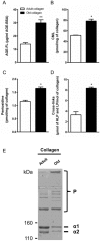
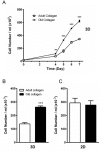
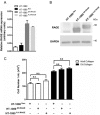
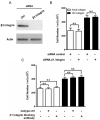
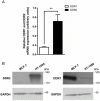



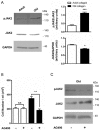
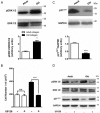
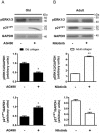

Similar articles
-
Clustering, Spatial Distribution, and Phosphorylation of Discoidin Domain Receptors 1 and 2 in Response to Soluble Collagen I.J Mol Biol. 2019 Jan 18;431(2):368-390. doi: 10.1016/j.jmb.2018.11.015. Epub 2018 Nov 17. J Mol Biol. 2019. PMID: 30458172 Free PMC article.
-
DDR1 and DDR2 physical interaction leads to signaling interconnection but with possible distinct functions.Cell Adh Migr. 2018;12(4):324-334. doi: 10.1080/19336918.2018.1460012. Epub 2018 Jun 25. Cell Adh Migr. 2018. PMID: 29616590 Free PMC article.
-
Discoidin domain receptor 2 mediates collagen-induced activation of membrane-type 1 matrix metalloproteinase in human fibroblasts.J Biol Chem. 2017 Apr 21;292(16):6633-6643. doi: 10.1074/jbc.M116.770057. Epub 2017 Mar 7. J Biol Chem. 2017. PMID: 28270508 Free PMC article.
-
Discoidin domain receptors: Micro insights into macro assemblies.Biochim Biophys Acta Mol Cell Res. 2019 Nov;1866(11):118496. doi: 10.1016/j.bbamcr.2019.06.010. Epub 2019 Jun 21. Biochim Biophys Acta Mol Cell Res. 2019. PMID: 31229648 Free PMC article. Review.
-
Role of discoidin domain receptor 2 in wound healing.Histol Histopathol. 2014 Nov;29(11):1355-64. doi: 10.14670/HH-29.1355. Epub 2014 Apr 29. Histol Histopathol. 2014. PMID: 24781958 Review.
Cited by
-
LRP-1 Promotes Colon Cancer Cell Proliferation in 3D Collagen Matrices by Mediating DDR1 Endocytosis.Front Cell Dev Biol. 2020 Jun 3;8:412. doi: 10.3389/fcell.2020.00412. eCollection 2020. Front Cell Dev Biol. 2020. PMID: 32582700 Free PMC article.
-
Collagen and Discoidin Domain Receptor 1 Partnership: A Multifaceted Role in the Regulation of Breast Carcinoma Cell Phenotype.Front Cell Dev Biol. 2021 Dec 22;9:808625. doi: 10.3389/fcell.2021.808625. eCollection 2021. Front Cell Dev Biol. 2021. PMID: 35004699 Free PMC article. Review.
-
DDR1 and DDR2 in skin.Cell Adh Migr. 2018;12(4):386-393. doi: 10.1080/19336918.2018.1485618. Epub 2018 Aug 1. Cell Adh Migr. 2018. PMID: 29952722 Free PMC article. Review.
-
Collagen type 1 promotes survival of human breast cancer cells by overexpressing Kv10.1 potassium and Orai1 calcium channels through DDR1-dependent pathway.Oncotarget. 2017 Jul 8;9(37):24653-24671. doi: 10.18632/oncotarget.19065. eCollection 2018 May 15. Oncotarget. 2017. PMID: 29872495 Free PMC article.
-
Prognostic risk analysis related to radioresistance genes in colorectal cancer.Front Oncol. 2023 Jan 18;12:1100481. doi: 10.3389/fonc.2022.1100481. eCollection 2022. Front Oncol. 2023. PMID: 36741692 Free PMC article.
References
-
- Bailey AJ, Paul RG, Knott L. Mechanisms of maturation and ageing of collagen. Mech Ageing Dev. 1998;106:1–56. - PubMed
-
- Logsdon CD, Fuentes MK, Huang EH, Arumugam T. RAGE and RAGE ligands in cancer. Curr Mol Med. 2007;7:777–789. - PubMed
-
- Bartling B, Desole M, Rohrbach S, Silber RE, Simm A. Age-associated changes of extracellular matrix collagen impair lung cancer cell migration. FASEB J. 2009;23:1510–1520. - PubMed
MeSH terms
Substances
LinkOut - more resources
Full Text Sources
Other Literature Sources
Medical
Research Materials
Miscellaneous

